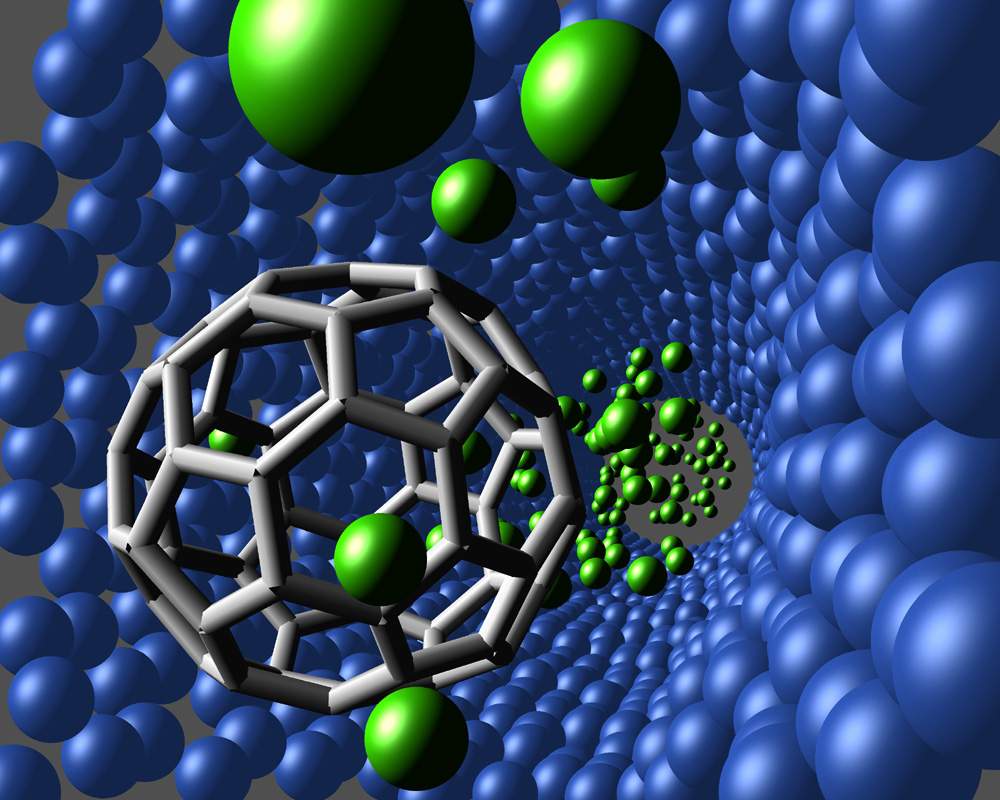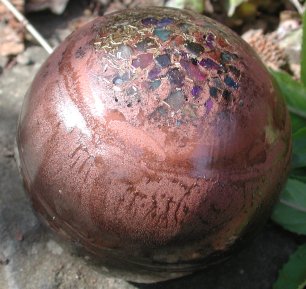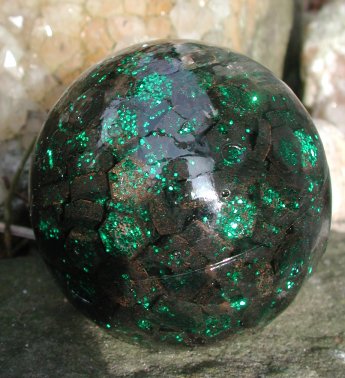2012 Buckyballs
Carbon, the second most plentiful element in the human body is tetrahedral in geometry. The tetrahedron is the building block of consciousness as well. It takes a minimum of 5 tetrahedrons to make a cube. Here is a very interesting video about geometry and 2012 synchs:
https://www.youtube.com/watch?v=EMqZ1zLLRHw&list=UULF2DONV6JCJU...
A Buckyball is a slang word for Carbon 60. C60 molecules made up of 60 carbon atoms arranged in a series of interlocking hexagons and pentagons form a structure that looks similar to a soccer ball. C60 is actually a "truncated icosahedron", consisting of:
20 hexagons and 12 pentagons = 2012 .

Buckyballs are found all over the universe:


C60 molecules are the only molecule composed of a single element which can form a hollow spheroid which gives the potential for filling it, and using it for novel delivery systems.
"The buckyball, being the roundest of round molecules, is also quite resistant to high speed collisions. In fact, the buckyball can withstand slamming into a stainless steel plate at 15,000 mph, merely bouncing back, unharmed. When compressed to 70 percent of its original size, the buckyball becomes more than twice as hard as its cousin, diamond."
The process of knocking one or more carbon atoms out of the Buckyball structure and replacing it with metal atoms is known as doping, and the molecule in its altered form is often referred to as a dopeyball. The electrical and magnetic properties of dopeyballs have been the subject of intense study, which has already resulted in the discovery that potassium-doped Buckyballs are capable of superconducting at 18 K and those doped with rubidium superconduct at 30 K.
What is perhaps most amazing about Buckyballs is that despite their circuitous discovery in the laboratory, they have been naturally present on Earth all along. The earliest evidence that Buckyballs occur in nature was discovered by Arizona State University researchers Semeon Tsipursky and Peter Buseck, who found that a sample of rare, carbon-rich rock called shungite, estimated to have been formed between 600 million and 4 billion years ago, contained both C60 and C70 fullerenes. Since then, the fascinating molecules have also been identified in meteorites, impact craters, and materials struck by lightning. This new information has led some scientists to speculate about the role that fullerenes may have played in the development of life on Earth. Indeed, gases are known to become readily trapped inside the hollow molecules, and one research group has already found evidence of a form of helium in Buckyballs taken from the Sudbury crater (which contains the greatest known concentration of fullerenes in the world) that likely originated not inside of our own solar system, but within a red giant star. Thus, many consider it to be theoretically possible that Buckyballs carried from their stellar origin both the carbon essential to life and the volatiles that helped produce the planetary conditions necessary for life to begin.
Shungite and Orgone: http://www.thebluesun.co.uk/shungite.htm
Shungite and Orgone were made for each other. Orgone absorbs and transmutes energies. Shungite absorbs and needs clearing once it is full. Shungite powder mixed into resin with powdered metal and gold leaf makes a very powerful piece of Orgone because in this partnership the Shungite is constantly cleared and the absorption of the orgone is increased. This is to date one of the most powerful Orgone energy combinations we have found. They Rock!
Shungites and their amazing qualities are long time known. People of the Russian North are telling stories of miraculously getting healed after drinking water infused on a plain black stone. After becoming aware of the power, hidden inside this remarkable mineral, Tzar Peter the Great has commanded to establish a resort in a vicinity of the shungite deposit in Karelia and grown up to be its regular visitor. http://www.koksu.kz/koksu/gb_en/shungit.html
|
|
Tags:
Replies to This Discussion
-
Permalink Reply by Darren on April 23, 2012 at 2:08pm
-
Buckyballs and Health
Diet of buckyballs nearly doubles rat lifespan
By Brian Dodson
22:08 April 22, 2012
Sometimes I (almost) envy mice, rats, and yeast - it seems that almost any aging research we carry out on them doubles their lifespan and returns semi-senescent (say, a human equivalent of about 60 years of age - not thinking of anyone in particular, of course) to youthful vigor. It now appears that dramatic anti-aging results are associated with dietary ingestion of buckyballs, more properly known as C-60 fullerene.
A recent French study looking for chronic toxicity resulting from ingesting buckyballs dissolved in olive oil found that 10 month old rats who ingested the human equivalent of a tenth of a gram of C-60 buckyballs (which in technical grades cost less than US$10/gram) several times a week showed extended lifespans instead of toxic effects.
All C-60-treated rats survived to at least 59 months, with the oldest surviving to 66 months. The control group lived for periods ranging from 17 months to 37 months, while an additional group fed only the extra olive oil lived for periods of 36 to 57 months. For the curious, the olive oil dosage was equivalent to a person adding about eight tablespoons of uncooked olive oil to their daily diet without compensating for the additional calories. Similar results have been reported for mammals held in a state of semi-starvation, but that is obviously not a pleasant lifestyle.
All fullerenes are susceptible to clumping when dissolved in oil, so the preparation of the olive-oil/C-60 solution is rather lengthy. In these tests, 50 mg of C-60 buckyballs were added to 10 ml of virgin olive oil. These were stirred for two weeks at ambient temperatures with no incident light. Following the stirring, the solutions were centrifuged at 5,000 g for an hour. The fluid was separated from the precipitate, and was then passed through a 0.25 micron filter. The resulting liquid contained 0.8 mg/ml of C-60 buckyballs.
The results beg the question - what is going on here? Is the life extension just for those lucky rats again, or is there a mechanism that might transfer over to humans? The study was aimed at discovering if a diet of buckyballs has any toxic effects, and the good news is that no toxicity was found. The buckyballs did move throughout the body (including the brain and central nervous system), and even enter individual cells. The ingested C-60 had an elimination half-life from blood of about 10 hours, so was essentially fully eliminated from the body within two days. It is not clear from the report if the C-60 was eliminated from intracellular fluid on that time scale.
Although fullerenes are composed of sp2 carbons in a similar manner to graphite, fullerenes are soluble in various common organic solvents. Due to their hydrophobic nature, fullerenes are most soluble in CS2 (C60 = 7.9 mg/mL) and toluene (C60 = 2.8 mg/mL). Although fullerenes have a conjugated system, their aromaticity is distinctive from benzene that has all C-C bonds of equal lengths, in fullerenes two distinct classes of bonds exist. The shorter bonds are at the junctions of two hexagons ([6, 6] bonds) and the longer bonds at the junctions of a hexagon and a pentagon ([5,6] bonds). This difference in bonding is responsible for some of the observed reactivity of fullerenes. There is a harmonic overtone reached when the two bonds oscillate their exchange.
Specific studies of the effect of C-60 buckyballs on oxidative stress in the rats were performed by studying the effects of carbon tetrachloride (CCl4) injection. Carbon tetrachloride is well known to be poisonous to rats, being highly hepatotoxic (toxic to the liver). It is also associated with delirium and intoxication such as is experienced in the abuse of solvents.
Rats which had been pretreated by water, by olive oil, and by olive oil containing C-60 buckyballs all showed typical signs of intoxication within a few minutes of CCl4 injection. However, while intoxication persisted in the water and olive oil groups for 24 hours, the olive oil and C-60 group emerged from intoxication after only five hours.
In rats experiencing the pretreatment, but unexposed to carbon tetrachloride, autopsy revealed essentially normal livers. In those given a CCl4 injection, however, the livers from rats pretreated with water or olive oil showed important damage - a great deal of inflammation as well as large necrotic areas (dying or dead tissue). In contrast, the livers from rats pretreated with olive oil and C-60 buckyballs showed little damage or CCl4-induced cell death. Biochemical markers of liver damage showed far less elevation in the rats pretreated with olive oil and C-60.
It does appear there is a real physiological effect on metabolic processes, and that oxidative stress in particular is significantly reduced in rats by chronic oral ingestion of an olive oil/C-60 solution. As oxidative stress is one of the factors usually associated with aging, there may well be a reasonable mechanism for the lifespan extension, especially if excess oxidation within individual cells is prevented by intracellular buckyballs. Will people react to a treatment of this sort with lifespans of 180-200 years? Only time will tell.
The research was recently published in the journal Biomaterials
- ‹ Previous
- 1
- 2
- Next ›
About
© 2025 Created by Sevan Bomar.
Powered by
![]()

